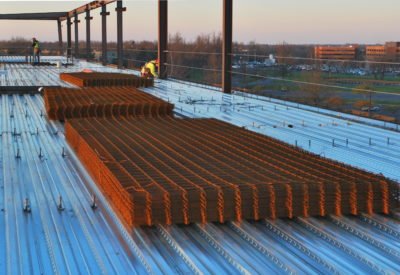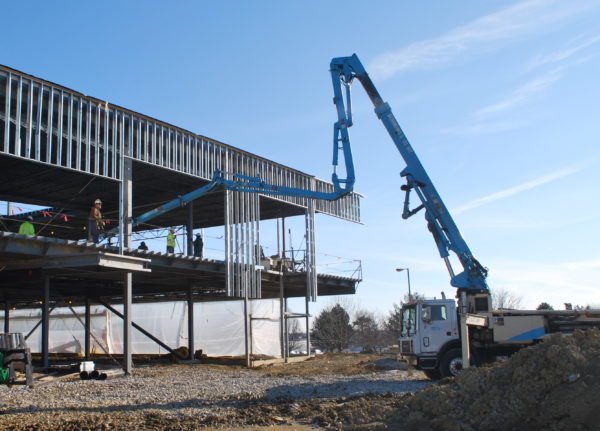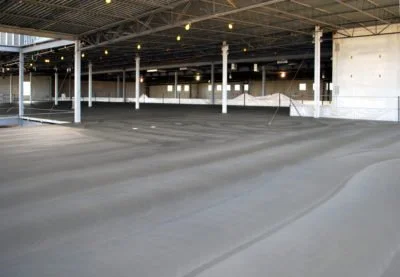Steel Deck? Steel Fibers!
The most common concrete floor type is the ground-supported slab, also known as slab on ground or slab on grade. Second in popularity, at least in North America, comes the composite slab, a type of suspended floor made of concrete over a steel deck. The two floor types have several things in common. Both are widely used; both are often misunderstood; and both benefit from steel fibers. However, steel fibers play a different role in each floor type.
Defining Terms
You who are structural engineers may want to skip this section.
A composite slab is a suspended floor that consists of concrete cast over a deck of corrugated sheet steel. The concrete doesn’t just sit on top of the steel deck, but is tightly connected to it, usually through dimples pressed into the steel. The dimples work like the deformations on rebar, connecting concrete and steel to make a composite structural element (Fig. 1).
Figure 1. Steel deck designed for a composite slab. Corrugations make the deck stiff. Dimples connect the deck to the concrete slab, allowing composite action. This particular deck is W3 Formlok from Verco Decking, Inc. Other manufacturers may use different shapes but the principles, including the benefits of steel fibers, remain the same.
Composite slabs go by several names. The Steel Deck Institute calls them composite steel floor deck-slabs, which is quite a mouthful. Out on the jobsite, they are often known as slabs on deck. That last term, though valid and concise, can be misleading — because not every slab on deck is composite. There are also noncomposite floors in which the steel deck serves only as a soffit form that is left in place. Such floors are designed as normal reinforced concrete slabs with internal reinforcement. The steel deck under a noncomposite slab is called a form deck, and it lacks the dimples that create composite action. I won’t say any more about non-composite slabs here, but you should know they exist.
The reinforcement in composite slabs is often classified as positive or negative. These terms have different meanings in structural engineering than they do in everyday speech. Positive reinforcement resists the tension caused by positive moment; negative reinforcement resists the tension caused by negative moment. In a floor slab, positive moment is the sagging that occurs between supports. Sagging puts the slab in tension at the bottom, so positive reinforcement goes in the lower part of the slab. Negative moment is the hogging that occurs over a support. Hogging puts the slab in tension at the top, so negative reinforcement goes in the upper part of the slab.
Three Kinds of Reinforcement
Composite slabs contain three distinct kinds of reinforcement: positive, negative, and crack-control. But not every floor gets all three.
Positive reinforcement, in every composite slab, is the steel deck. Located at the very bottom of the slab, it is in the ideal place to resist positive moment. Some designs include rebar near the bottom for extra positive reinforcement, but this is an addition to, not a replacement for, the steel deck.
Negative reinforcement normally consists of short lengths of rebar placed high in the slab, centered over the structural supports. Not every composite slab needs negative reinforcement. If the floor is what engineers call a simply supported span — a single span with a support at each end — there is no negative moment to worry about. Only floors with multiple spans experience negative moment, and even their designers may choose to treat each span as if it were simply supported, eliminating the need for negative reinforcement as a key part of the structural design.
Crack-control reinforcement deals with cracks that occur for any reason other than positive and negative moments. Because these nonstructural cracks are most often caused by temperature changes and concrete’s drying shrinkage, they are sometimes called temperature and shrinkage cracks. They do not affect the floor’s ability to support loads, but they can look bad and reduce a floor’s serviceability if they grow too wide. Crack-control reinforcement aims not to prevent nonstructural cracks, but to limit their width.
The role of steel fibers in a composite steel-deck slab is normally confined to the third kind of reinforcement: crack-control. You don’t need steel fibers for positive reinforcement because the steel deck does that job. You could, conceivably, use steel fibers for negative reinforcement, but rebar is generally more efficient for this purpose, because you can confine it to the locations of high negative moment instead of spreading it throughout the slab.
Wire Mesh - Traditional but Flawed
Traditionally, designers have specified wire mesh to control cracks in composite slabs. The Steel Deck Institute has long endorsed this practice, calling for steel equal to at least 0.075% of the slab’s cross-sectional area (The area is measured above the deck flutes.).1 Some engineers call for more than the minimum, up to eight times as much, hoping to keep cracks tighter than usual.Wire mesh works — if it is lapped properly, and if it is supported high in the slab so it can limit crack width at the floor surface. But those are big ifs that often go unsatisfied. It turns out that wire mesh suffers from five serious drawbacks.
First, mesh often ends up too low. To control cracks effectively, it needs to be near the slab’s top surface — but all too often it ends up near the bottom instead. Some contractors still try to place mesh by pulling it up with hooks as concrete is placed around it, but this technique, long discredited, rarely succeeds. Supporting the mesh on chairs or bolsters is better, but it’s less reliable than you might suppose. The mesh normally used in steel-deck slabs is so floppy it sags badly (Fig. 2) unless the supports are very close together. Concrete contractor Joe Neuber, in a 2006 article, presents strong evidence that the normal support spacings are too wide, and that for wire sizes of 4.0 and smaller the supports should be placed just 12 inches apart.2 Hardly anybody does that, but apparently it’s what we really need to keep the mesh where it belongs. Recognizing the near-impossibility of placing light-gauge wire mesh at the right height, the American Society of Concrete Contractors says that its members “will use sheet or rolled WWR
[welded wire reinforcement, another term for wire mesh] of size 4.0 or smaller if required by specification, but only with the acknowledgement that the risk associated with the location of the reinforcement is entirely the responsibility of the specifier.”3
Figure 2. Wire mesh sagging between supports. I bet it doesn’t look like this on the drawings.
Second, mesh sometimes ends up too high. Though it’s rare for a whole mat to be installed too high, often a corner will stick up above the floor surface. If the concrete finishers catch this in time, they can snip off the offending wires with bolt cutters, but that’s messy. If they don’t catch it in time, wires must be cut out of the hardened concrete, leaving damage that must be patched.
Third, mesh comes in sheets that must be lapped to provide continuous reinforcement. Specifications typically call for a minimum lap of one space (the distance between cross wires) plus 2 inches. The Wire Reinforcement Institute recommends tying the sheets together at all laps, though that advice is often ignored.4 If the mesh shifts before or during the concrete pour, the laps can easily disappear, leaving gaps where cracks can open wide. And even if the mesh doesn’t shift, laps can cause trouble. With some layouts, you end up with locations where four layers overlap. That’s a lot of wire to cram into what can be a tight space, and it can lead to the problem mentioned in the previous paragraph: mesh sticking out of the floor surface.
Fourth, installing mesh takes a lot of work. You have to hoist it to deck level with a crane or a forklift, staging it on the deck (Fig. 3). Then you have to carry each sheet to its final position, making sure it is at the right height and the laps are correct. That step is usually done by hand. Inevitably some mats have to be cut to size, and to fit around columns and other obstructions. It all adds up to a substantial labor charge.
Figure 3. Wire mesh must be hoisted to deck level and staged there before it is finally set in place. Each step takes time and costs money. In contrast, steel fibers arrive in the concrete truck and are placed along with the concrete, usually by pump.
Last, mesh causes injuries. Walking on corrugated steel is tricky even when the deck is bare, and mesh makes it worse. The risk of tripping is always there, and it rises if the mesh is chaired up, as it should be if you want it to do its job.
Steel Fibers - The Replacement for Wire Mesh
Steel fibers eliminate all five of the drawbacks listed above. Unlike wire mesh, fibers are always distributed throughout the concrete slab. You won’t find them concentrated at the bottom or the top. Unlike wire mesh, fibers don’t rely on carefully maintained laps. Unlike wire mesh, fibers require little labor to install. They are added to the concrete trucks, usually at the ready-mix plant but sometimes on site, and they are delivered to the deck along with the concrete. And unlike wire mesh, fibers don’t cause trips and falls.
Figure 4. This concrete contains steel fibers at 25 pcy. The fibers had no noticeable effect on the concrete placement.
Since 2006, the Steel Deck Institute has endorsed the use of steel fibers for crack control in composite slabs. The recommended minimum dosage is at least 25 pcy (pounds per cubic yard).5 As with mesh, some engineers specify more than the code minimum when they want better-than-usual control over cracks. Some composite slabs have been built with a fiber dosage of 50 pcy. Dosage rates above 50 pcy are rare but not impossible.
Objections to Steel Fibers
Are there reasons not to switch from wire mesh to steel fibers? Two objections to steel fibers are often raised: that fibers will make the concrete hard to pump, and that fibers will show at the floor surface. Both objections can be valid, but the right fiber goes a long way toward overcoming them.
Figure 5. Steel fibers need not interfere with pumping.
Concrete placed on deck is usually delivered by pumping (Fig. 5), so contractors naturally want a mix that pumps easily and won’t clog. Steel-fiber-reinforced concrete has not always met that need. But if you look at the jobs where fibers interfered with pumping, almost all involved long fibers or very high dosages, or both. Few problems arise when you use CFS fibers at the standard dosage rate of 25 pcy. Such fibers have even been used at 50 pcy with no noticeable effect on pumpability.
The objection to exposed fibers is a little harder to deal with. As I’ve said before, if your tolerance for exposed fibers is literally zero — that is, not one fiber in sight — don’t use fibers. But that’s an extreme position. With 1-inch fibers and a little care in striking off the concrete, you can keep exposure to a low level that will satisfy almost all floor users (Fig. 6). And let’s not forget that most composite slabs get floorcoverings, which make fiber exposure irrelevant.
Figure 6. This concrete contains steel fibers at 25 pcy. They did not affect the finish.
Expectations
Whether using wire mesh or steel fibers to control cracks, we need to understand what they can and cannot do. Both products can and will limit crack width. But neither product can prevent cracks altogether. In composite slabs, crack prevention seems to be an unreachable goal. Because of the restraint caused by the steel deck, and also because of the negative moments which are present in most floors, composite slabs are bound to crack. The best we can hope for is to keep cracks harmless by limiting their width.
This reveals a difference between how steel fibers work in composite and ground-supported slabs. In ground-supported floors, fibers prevent cracking if you use enough of them. Closely spaced fibers stop micro cracks from growing into cracks you can see. This is the key to wide-slab construction with steel fibers, a method that allows slabs up to 125 feet long without intermediate joints or visible cracks. But that kind of crack prevention works only in slabs that are free to shrink. Composite slabs are never free because the steel deck restrains them. For this reason, fibers in composite slabs cannot prevent all cracking; they can only control it.
Negative-Moment Cracking
The widest cracks in a composite slab usually show up over beams and girders, where negative moment is present. Steel fibers won’t necessarily keep such cracks acceptably tight — and neither will wire mesh, for that matter. The Steel Deck Institute says: “The reinforcement chosen for temperature and shrinkage reinforcement most likely will not supply sufficient area of reinforcement for negative bending over the supports.”6
What do we do about negative-moment cracking, then? The Steel Deck Institute has two suggestions. One option is to ignore negative moments. Design the floor as if each span were simply supported (even though it really isn’t), and let the cracks open wide over the beams and girders. According to the Institute, most standard design tables for composite slabs are based on this notion. The other option is to design for continuity, using the reinforced-concrete principles set out in ACI 318. This option requires negative reinforcement running perpendicular to, and centered on, the beams and girders. The negative reinforcement is usually in bar form, though strips of wire mesh are also possible.
A third solution is sometimes suggested: Saw a joint directly over the beam or girder. Sawn joints control cracks pretty well in ground-supported slabs, so it hardly seems outrageous to think they could do the same in composite slabs. However, this approach has not proven consistently successful. Sometimes a crack appears right next to the joint.
Switching to Steel Fibers
Converting a composite-slab design from wire mesh to steel fibers is easy.
Confirm that the wire mesh is being used to control temperature and shrinkage cracks, not to provide positive or negative reinforcement.
Determine the fiber dosage. If the mesh is the minimum required by the Steel Deck Institute — 0.075% of the slab’s cross-sectional area or 6×6, W1.4xW1.4, whichever is greater — replace it with the minimum fiber dosage: 25 pcy. If the mesh is heavier than the minimum, increase the fiber dosage in proportion.
Specify the fiber type, length, and aspect ratio (or effective diameter, if you prefer). At Concrete Fiber Solutions, we recommend (1) our CFS100-2 fiber, a Type II fiber, 1 inch long, with an aspect ratio of 43 (effective diameter 0.023 inch) or (2) our CFS150-5 fiber, a Type V fiber, 1 1/2 inch long, with an aspect ratio of 38.
Don’t change the steel deck.
If the design includes negative reinforcement, or positive reinforcement that’s in addition to the steel deck, leave it in. Don’t try to replace it with fibers.
Now you are ready to enjoy a deck pour without wire mesh.
Steel Deck Institute, SDI C-2011, “Standard for Composite Steel Floor Deck-Slabs”, 2011, p. 17.
Joseph Neuber, “Support Requirements for Welded-Wire Reinforcement in Slabs”, Concrete International, September 2006, p. 40.
American Society of Concrete Contractors, ASCC Position Statement 2, “Location of Welded-Wire Reinforcement in Concrete Slabs”, 2012.
Roy H. Reiterman, Technical Consultant to the Wire Reinforcement Institute, “A Sample Specification for Welded Wire Reinforcement”, March, 2006.
Steel Deck Institute, SDI C-2011, “Standard for Composite Steel Floor Deck-Slabs”, 2011, p. 17.
Steel Deck Institute, SDI C-2011, “Standard for Composite Steel Floor Deck-Slabs”, 2011, p. 15.






